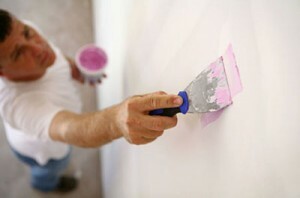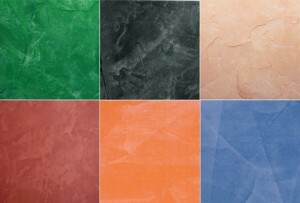How to plaster plasterboard: features of this type of finish
Table of contents
- 1 Determine the need for plaster
-
2 application technology
- 2.1 Preparing for the final finishing of walls
- 2.2 Primer
- 2.3 plastering
- 3 Decorative plaster drywall
- 4 Summing up
Sometimes during the repair of the premises, which are covered with gypsum plasterboard walls, the question arises - how to plaster drywall?
Despite its apparent simplicity, the question is not idle, because drywall is often called "dry plaster."
 It is in the subtleties rather complex and ambiguous relationship coatings and plasters, we try to understand the material.
It is in the subtleties rather complex and ambiguous relationship coatings and plasters, we try to understand the material.So, the first, and the main question - is it possible to plaster drywall?
To date, no consensus on the matter, alas, no. Many experts are inclined to the surface such that the plaster (and especially if the wall is made of fairly cheap, nevlagostoykogo sheet) can not in any case.
Sooner or later, the ground under the influence of moisture from the composition and its rather big mass deforms, leading to cracking of the layer.
However, there is an alternative view, which says that the plastering drywall possible. If cautiously, of course.
In this case the "careful" means, first of all:
- Application of the plaster on the wall with their hands only on moisture-resistant sheet.
- The use of special primers deep penetration.
- The distribution of mass in thin layers in several steps.
The only exception, for which specialists are showing a unanimous opinion, is the application of decorative plaster with your hands. She applied to the sheet is not only possible, but necessary, such a mass is one of the most popular materials for the walls.
Determine the need for plaster
As you have probably realized, drywall plaster - quite a hard task sometimes with unpredictable results. Such is the characteristics of the sheet, it may actually deform under a thick layer of furnish. And can stand for many years.
So when do you need to plaster?
- If the paneling has a significant curvature or bias, this problem will not solve the finish, and in the future it may significantly worsen. If you are a "happy" owner of such a wall, do not fight with the consequences better, and remove the cause. Severe curvature can be corrected only by rewiring, replacing the sheets on the moisture-proof.
- But minor irregularities in the skin plaster is still possible. Also, the mixture is applied over dents sense and pre-plastered joints.
- Well, the only case (it was already mentioned above) - is the use of decorative coatings. There are practically no limitations, as the decorative mass is applied usually sufficiently thin layer, and its composition provides rapid polymerization and drying.
Proper preparation of the walls and maintaining the technology application to the carrier does not lead to negative consequences.
So, suppose you have already decided whether you need to plaster drywall, if you can manage putty. It remains to choose the most appropriate technology and the composition of the mixture. Proceed.
application technology
When applying should follow technology works, minor infractions can lead to undesirable consequences.
Preparing for the final finishing of walls
- Surface to be cleaned from dust, which inevitably is produced during its installation. It is best suited for this industrial vacuum cleaner, but in its absence, you can remove the dust with improvised means.
- The next step - filling seams, joints and unevenness. For fillings it can be used as prepared, and the dry mixture based flooring. When dry blends are used, they are prepared directly before use.
- Initially, fill the cavity filler seams and big bumps. Once the putty has hardened, causes the leveling layer.

Putty
- You can now move on to the key stages of preparation - priming.
Primer
specific primer mixture (such as Tiefgrund LF or similar in characteristics) are used for grounds. Such primers penetrate deeply into the base and reinforce its thickness, providing adhesion mixtures.
For best effect at this point it is better to use acrylic primer, which have vapor permeable properties (non-insulated steam).
The primer is applied in one layer using a roller or brush (for walls with a small area).
Note! Works on drywall carried out only after the first coat is completely dry! For acrylate primers drying time is 1-2 hours.
Once the stopper and seams primer applied, can move to alignment walls.
plastering
Instructions for distribution of plaster with your hands:
Mass applied in a thin layer (as thin as 2.3 mm) using a wide spatula or metallic trowels. If the plaster used for leveling deep irregularities, carry out the distribution in several stages. Note that in this case it is better to put 3-4 layers of several millimeters than 1 thick layer immediately.
not any plaster base for finishing the surfaces of the drywall. It is best to use a mixture based on gypsum binder (e.g., Knauf Rotband). In order to furnish better "hold" can be used steklotkannuyu grid with a cell 5 mm.
After the plaster layer was completely dried, it is possible to start finishing walls of plasterboard. In this case, for finishing is better to use vapor-permeable materials that do not interfere with the output of the steam out of the finish.
Decorative plaster drywall
To finish the surfaces of the drywall is best to use a fine decorative plaster. This is because stacking of coarse fractions requires applying a sufficiently thick layer and in the case of plasterboard walls is desirable.
The process is as follows:
Plasterboard substrate must be clean and dry. Before starting work, must be completely de-dusted surface.
Once freed of dust surface begin to putty joints. Sutures fill the filler in several stages to ensure adequate time for coating has dried and polymerized. As a result, the seams and irregularities should be ground in one plane with plasterboard.
Note! When aligning drywall surface under the decorative plastering can not achieve a smooth surface so as when aligned for painting. Texture plaster well hides all the bumps.
On the base plastered inflict acrylate primer. For decorative plastering using the same primers as for finishing drywall common lime plaster. The primer is applied in one step, one layer.
On primed drywall plastering. Coating was carried out with a spatula or trowel, a layer of 2-3 mm.
Immediately after the plaster is applied, proceed to the formation of relief. Relief forming with a sponge, a brush with stiff bristles rare, trowel, spatula shaped.
Note! When applying plaster on a plaster base during formation of the relief should not apply excessive force. This can lead to plasterboard deformation.
Further processing (coloring, protective coating composition) may be carried out only after the final drying surface.
Summing up
Now that you know how to plaster drywall. In order to more accurately understand the technological and practical issues on our website provides detailed photo and video instruction, in which you will find the necessary information on the question. Good luck!


